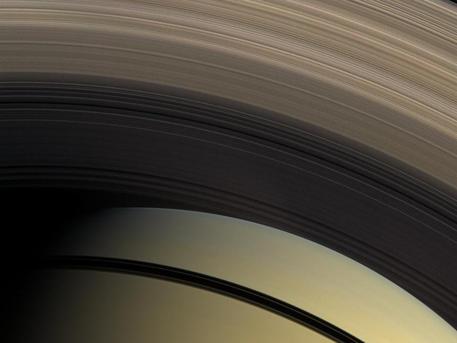Strange Weather On Saturn
Cassini Shows Saturnian Roller Derby
 © NASA/JPL/SSI |
This natural color view from the Cassini spacecraft highlights the myriad gradations in the transparency of Saturn's inner rings.
"This rambunctious system gives us a new feel for how an early solar system might have behaved," said Linda Spilker, a planetary scientist. "This kind of deep, rich data can only be collected by an orbiting spacecraft, and we look forward to the next seven years around Saturn bringing even more surprises."
In the paper describing the elegant mess of activity in the rings, lead author Jeff Cuzzi describes how Cassini has shown us that collisions are routine and chunks of ice leave trails of debris in their wakes. Spacecraft data have also revealed how small moons play tug-of-war with ring material and how bits of rubble that would otherwise join together to become moons are ultimately ripped apart by the gravitational pull that Saturn exerts.
During equinox, the period when sunlight hits the rings exactly edge-on, Cassini witnessed rings that are normally flat - about tens of yards thick - being flipped up as high as the Rocky Mountains.
The spacecraft has also shown that the rings are composed mostly of water ice, with a mysterious reddish contaminant that could be rust or small organic molecules similar to those found in red vegetables on Earth.
"It has been amazing to see the rings come to life before our very eyes, changing even as we watch, being colorful and taking on a tangible, 3-D nature," Cuzzi said. "The rings were still a nearly unstructured object in even the best telescopes when I was a grad student, but Cassini has brought us an intimate familiarity with them."
Cuzzi said Cassini scientists were surprised to find such fine-scale structure nearly everywhere in the rings, forcing them to be very careful about generalizing their findings across the entire ring disk. The discovery that the rings are clumpy has also called into question some of the previous estimates for the mass of the rings because there might be clusters of material hidden inside of the clumps that have not yet been measured.
Cassini helped scientists understand a south polar vortex that has a diameter 20 to 40 times that of a terrestrial hurricane, and the bizarrely stable hexagon-shaped jet stream at the planet's north pole. Cassini scientists have also calculated a variation in Saturn's wind speeds at different altitudes and latitudes that is 10 times greater than the wind speed variation on Earth.
"We learned from Cassini that the Saturnian magnetosphere is swimming in water," Gombosi said. "This is unique in the solar system and makes Saturn's plasma environment particularly fascinating."
Of course, Cassini's intense investigation has opened up a host of new mysteries. For example, Cassini has shown us images of occasional cannon-ball-like objects that rocket across one of the outer rings known as the F ring, without many clues about where they came from or why they quickly disappear.
"Cassini has answered questions we were not even smart enough to ask when the mission was planned and raised a lot of new ones," Cuzzi said. "We are hot on the trail, though."
Source: NASA
Strange Weather On Saturn
Cassini Shows Saturnian Roller Derby
 © NASA/JPL/SSI |
This natural color view from the Cassini spacecraft highlights the myriad gradations in the transparency of Saturn's inner rings.
"This rambunctious system gives us a new feel for how an early solar system might have behaved," said Linda Spilker, a planetary scientist. "This kind of deep, rich data can only be collected by an orbiting spacecraft, and we look forward to the next seven years around Saturn bringing even more surprises."
In the paper describing the elegant mess of activity in the rings, lead author Jeff Cuzzi describes how Cassini has shown us that collisions are routine and chunks of ice leave trails of debris in their wakes. Spacecraft data have also revealed how small moons play tug-of-war with ring material and how bits of rubble that would otherwise join together to become moons are ultimately ripped apart by the gravitational pull that Saturn exerts.
During equinox, the period when sunlight hits the rings exactly edge-on, Cassini witnessed rings that are normally flat - about tens of yards thick - being flipped up as high as the Rocky Mountains.
The spacecraft has also shown that the rings are composed mostly of water ice, with a mysterious reddish contaminant that could be rust or small organic molecules similar to those found in red vegetables on Earth.
"It has been amazing to see the rings come to life before our very eyes, changing even as we watch, being colorful and taking on a tangible, 3-D nature," Cuzzi said. "The rings were still a nearly unstructured object in even the best telescopes when I was a grad student, but Cassini has brought us an intimate familiarity with them."
Cuzzi said Cassini scientists were surprised to find such fine-scale structure nearly everywhere in the rings, forcing them to be very careful about generalizing their findings across the entire ring disk. The discovery that the rings are clumpy has also called into question some of the previous estimates for the mass of the rings because there might be clusters of material hidden inside of the clumps that have not yet been measured.
Cassini helped scientists understand a south polar vortex that has a diameter 20 to 40 times that of a terrestrial hurricane, and the bizarrely stable hexagon-shaped jet stream at the planet's north pole. Cassini scientists have also calculated a variation in Saturn's wind speeds at different altitudes and latitudes that is 10 times greater than the wind speed variation on Earth.
"We learned from Cassini that the Saturnian magnetosphere is swimming in water," Gombosi said. "This is unique in the solar system and makes Saturn's plasma environment particularly fascinating."
Of course, Cassini's intense investigation has opened up a host of new mysteries. For example, Cassini has shown us images of occasional cannon-ball-like objects that rocket across one of the outer rings known as the F ring, without many clues about where they came from or why they quickly disappear.
"Cassini has answered questions we were not even smart enough to ask when the mission was planned and raised a lot of new ones," Cuzzi said. "We are hot on the trail, though."
Source: NASA





